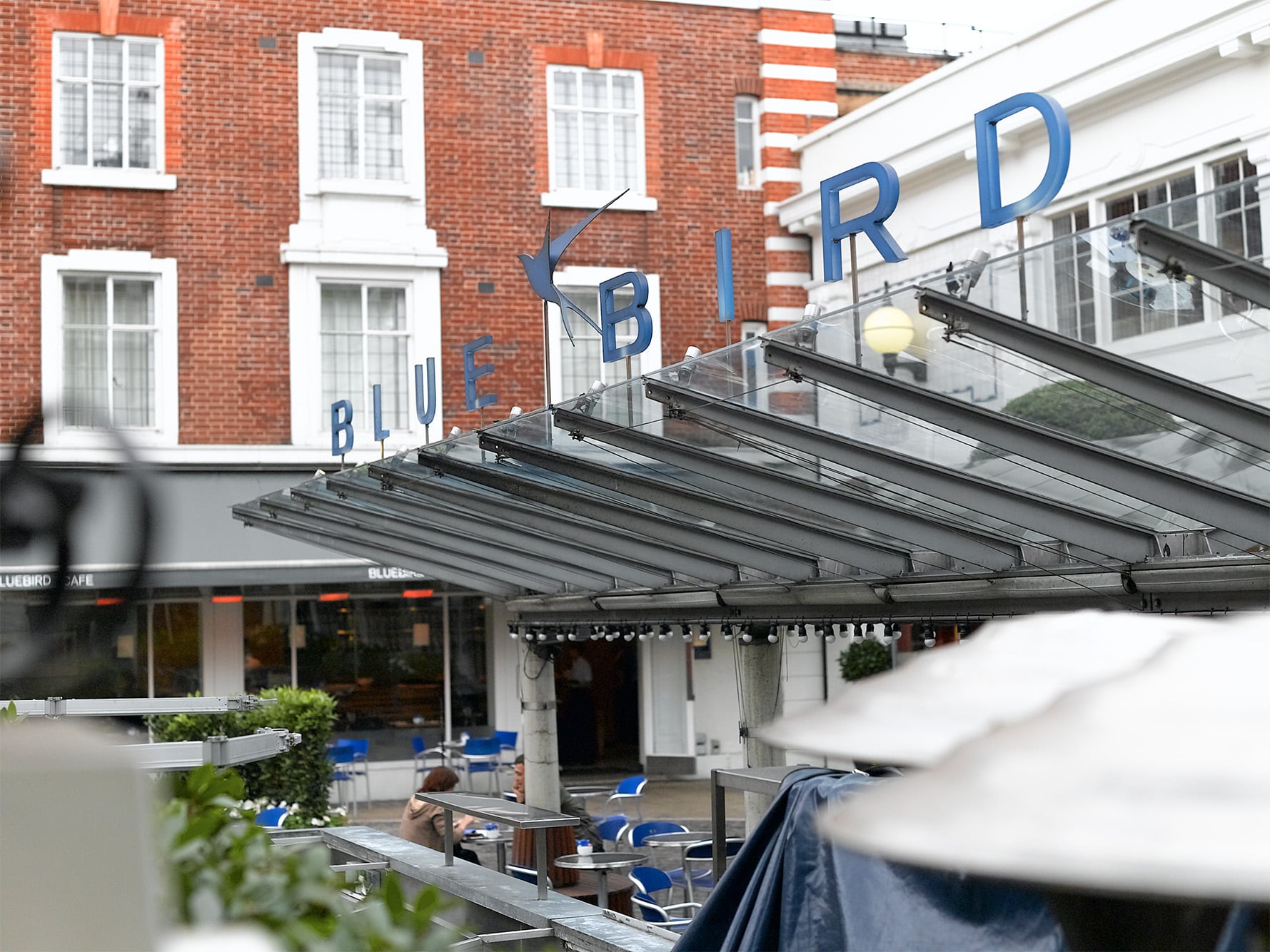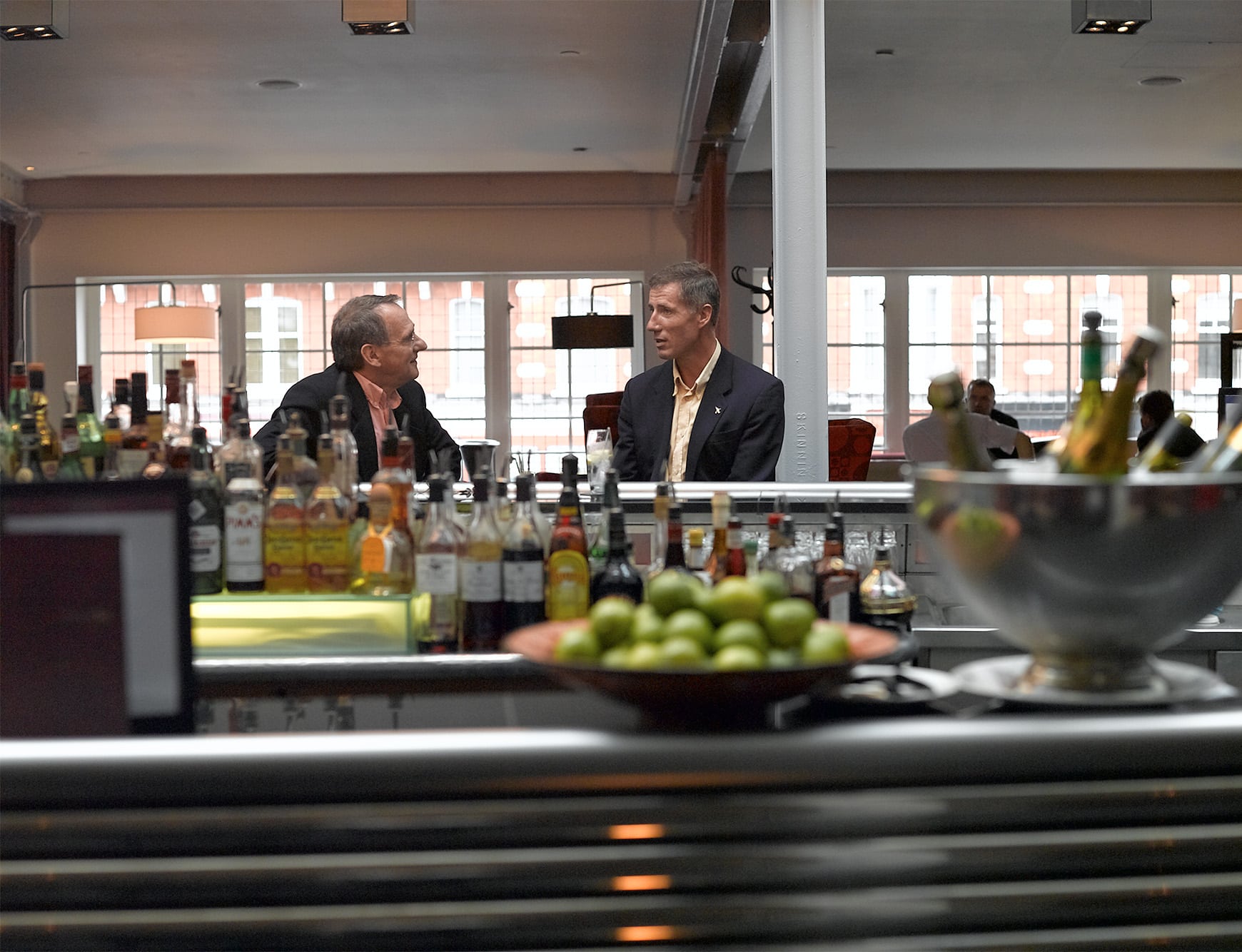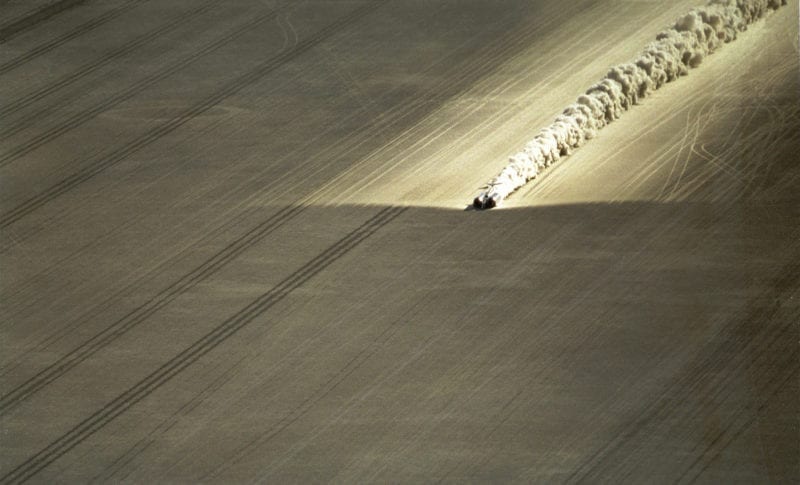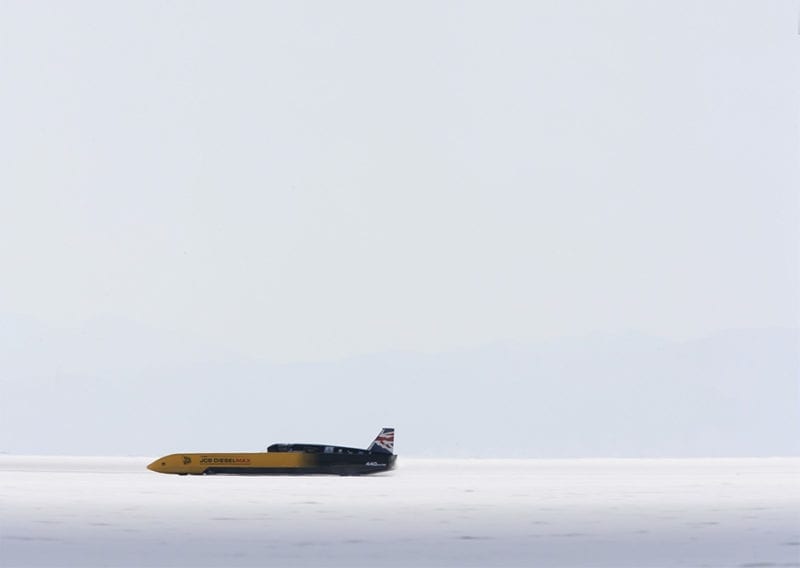Lunch with... Andy Green
The fastest man on earth is a patriot, and drove Thrust SSC for the glory of his country and its engineering skills

James Mitchell
In the 1920s and 1930s, the World’s Land Speed Record was all about heroes. Men of courage like Sir Henry Segrave (231mph), Sir Malcolm Campbell (301mph), George Eyston (357mph) and John Cobb (394mph) were feted by their country. More famous than the top circuit racers of their day, their faces smiled down from news-reel screens and their names were familiar to every schoolboy.
Today, Wing Commander Andrew Green, OBE is not as well known to the general public as were his LSR forbears. In the 21st century it’s Formula 1 drivers who are the media heroes, and few can really grasp the concept of a man driving a car across a lonely piece of desert faster than the speed of sound. Fewer still would understand that he risked his life doing this, for no payment. Or that he did it as a matter of nationalistic pride, and to underline the excellence of his country’s engineering prowess. Andy Green’s heroism is the old-fashioned sort, one that doesn’t make a fuss, and doesn’t produce good fodder for the tabloids. As a serving RAF officer, he had to use his normal annual leave to take part in the attempt, and he was back at work serving Queen and Country three days after setting the record.
A Phantom and Tornado pilot, he has seen service in East Germany, Bosnia, and more recently Afghanistan and Iraq. He has been part of the Defence Research Agency team at Farnborough, working on future generations of fighter aircraft, as well as RAF Attachment Commander in charge of the Harrier Squadron in Kandahar. Currently his role on the Air Staff Directorate involves crucial high-level strategic planning of on going military operations. His normal lunch routine is half an hour in the gym in the basement of the Ministry of Defence, or a brisk run along the Embankment, followed by a sandwich at his desk. But, 10 years almost to the day since he became the fastest man on earth, I persuaded him to have a proper lunch and to talk about it.
Andy revels in the heritage of the Land Speed Record. So his chosen venue, the Bluebird Restaurant in London’s Kings Road, was entirely appropriate: during the 1920s it was a garage, and Malcolm Campbell based his cars here. Tall and clean-cut, with a firm handshake and a steely eye, Andy is visibly very fit. His choice is healthy (scallops and sea bass, with a half-bottle of dry white Bordeaux) and then more indulgent (cheesecake).
His is an unusual mix of talents. He was 15 when he decided he wanted to be a pilot: his father had been in bombers in World War II. But from boyhood he was also a brilliant mathematician. In the same week he was offered a cadetship in the RAF and a place at Oxford. So the RAF sponsored him through University, and he duly got a mathematics first. The year he did, 1983, he was fascinated to read about a fellow called Richard Noble breaking the Land Speed Record.
In the LSR’s pre-war heyday, oil and tyre companies were delighted to sponsor record attempts, and bask in the reflected glory of each new mark. But by the 1950s record-breaking on land had gone out of fashion. There was a flurry of mainly American activity in the 1960s, punctuated by Donald Campbell’s oft-thwarted but ultimately successful efforts, and then in 1983 the brave Richard Noble brought the record back to Britain with Thrust 2’s 633.47mph.
With extraordinary determination and persistence, Noble continued to pursue his dream of a car that would beat the speed of sound, even though he had endless difficulties raising the money to do it. Companies happy to spend huge sums putting their logo on back-of-the-grid Formula 1 cars could not see the attraction of attaching themselves to the world’s fastest car. Most didn’t believe it would ever happen, or reckoned it would end in tragedy and the worst sort of publicity. Fortunately many members of the public felt differently, and much of the funding that kept Noble’s project alive came from donations to the Thrust website.

In 1994 Noble let it be known that he was looking for a driver for his supersonic car, and Andy, now a fully-fledged jet fighter pilot, applied. “I knew that the sound barrier would be the last great challenge in land speed record-breaking, and I believed it was very important for a British driver to be the first to do it. It was irresistible.”
There were 30 serious applicants. A sophisticated series of interviews and tests, including technological and psychological exercises and a day in a rally car on the loose, whittled them down to eight, all pilots of one sort or another. In February 1995 Green, then 32, was chosen.
Thrust SSC used two Rolls-Royce Spey jet engines slung either side of a narrow cockpit, riding on four solid wheels that had no tyres, because no tyre has ever been made that could begin to cope with supersonic speeds and forces. There were two wheels in front, conventionally spaced, and two mounted centrally at the back, in slightly staggered tandem, which steered.
“Think about a car weighing 10 tons. A car 54 feet long. With one hundred thousand horsepower. And with rear-wheel steering. Lots of people said it would never work. Professors of aerodynamics said a supersonic car couldn’t be done, and the assumptions they were making meant their reasons were entirely valid. Our task was to explore those assumptions without making something inherently dangerous.”
Finance was a constant problem throughout the project. “Everybody is amazed that we achieved what we did on so little money, and so are we. It was a five-year project involving a core team of 30 people, not all of whom were being paid, plus a lot of volunteers. Richard managed to run the whole project for £3 million. The thing was never properly resourced. We bought nothing we could borrow, and we borrowed nothing we could steal.
“Of course I didn’t expect to be paid. This was amateur motorsport at its absolute best. If you were driving a friend’s hillclimb car at Shelsley Walsh for the weekend, would you expect to be paid, or would you do it for fun? The RAF couldn’t give me any time off: I’m paid by the taxpayer, after all, and you can’t expect the taxpayer to fund a motor racing project. So I saved up my holiday over a year and a half to give me the days to do it.”
Richard Noble had started working on the Thrust SSC project in earnest in early 1994. The car first turned a wheel on a British runway in September 1995, but it wasn’t until October 1996 that it first ran on a desert.
“For that first test we flew SSC to the Al Jafr Desert in Jordan, 93 tons of kit in a chartered Antonov, and we managed four runs in four weeks. One end of the desert to the other, stop, five days while we re-engineer the car, one more run the other way. An F1 team may do 10,000 miles of testing in a season, to say nothing of wind tunnel work and so on. We needed four weeks to do what an F1 team could do in an hour.
“First off, the rear-wheel steering didn’t work. We hadn’t got the geometry right. Then we found this huge wheel shimmy problem. We adjusted the geometry, and put dampers on the wheels. We were faxing designs back to England, and new bits were being engineered overnight and flown out to Amman in pilots’ hand luggage. We were doing a lot of rapid prototyping, and developing the team skills out there in the desert. We got up to about 300mph, enough to show up the steering weaknesses, and then the rains came. So we loaded up again and flew home. When we got back we cut off the back of the car and re-engineered it completely.

“We went back to Jordan in May 1997. We got everything unloaded, got the desert marked out and cleared, and we managed nine runs in 13 days, which was a huge boost to the team. We were getting into summer temperatures, so we’d start at 5am and stop at 9am: after that it was too hot. The computer bays on the car were getting up to 100deg C. We started to use some quite high-end acceleration, and on the first full afterburner run I’m taking it nice and steady, 200, 250, 300, max burner, and suddenly it’s going all over the place. I just cannot keep it in a straight line.
“Driving a normal car, if it diverges, you respond to correct it. But I was getting into what in an aircraft you’d call a pilot-induced oscillation. The vehicle diverges, you put in a response through the steering wheel, it responds, you put in another, but at that point the vehicle is reversing its response, so you get a double input. You and the vehicle are working out of phase. Every time there’s the slightest input, say from irregularity in the desert surface or a crosswind, you’ve got to correct it. But if you start steering at the frequency of the car it gets worse, not better. I got out of the car that day and I said to myself, I think this project has just finished. The car’s unstable. I think we’re stuffed.
“I didn’t feel I could talk to Richard or anyone else about it, so I spent the night thinking it through. And I came up with the conviction that I was simply going to have to bully the car into being stable, go very high frequency with my steering movements to keep it under control, coupled with lower frequency inputs to steer it. I’d have to steer it at two separate frequencies, simultaneously. So that’s what I did, and it worked. I’d found a way to drive the thing. The downside was that I was never going to enjoy it. Imagine taking all the hairiest bits out of a three-hour sortie in a Tornado and doing them all in two minutes. It was the hardest thing I’ve ever done: like trying to balance the point of a pencil on the end of your finger.”
In September 1997 the team arrived at Black Rock Desert, Nevada for the official attempt. Unlike Bonneville, which is a salt surface, Black Rock is made up of a fine alluvial dried mud. If you pick up a chunk of it, you can crumble it into dust as fine as talcum powder. This slightly compliant surface works much better with the solid wheels than Bonneville’s salt, which is harsher. Over a five-week period Thrust SSC’s speed gradually increased.
“The figure that counts is a mean of two directions, and the rules say you have to do your two runs within an hour. So in real terms you have very little time to get everything turned round, download all the data, refuel, run the checks, get set up and then do it again. Our track was 14 miles long: the measured mile was in the middle, with 6.5 miles to accelerate, 6.5 miles to slow down.
“The acceleration is very slow to start with, because the air intakes are optimised for Mach 1, so at lower speeds they can’t get enough air to develop full power. Zero to 100mph takes about 20 seconds, winding the engines up to full power takes another eight seconds, and after that you’re putting on another 100mph every four seconds. So 200mph to 700mph takes 20 seconds. That’s over 1G: if you dropped a golf ball from the top of a building and jumped after it you’d be overtaking it. So it takes less than a minute to go supersonic from a standing start, and you’re supersonic for about four miles.
“At that speed it takes about 4.69 seconds to cover the measured mile. We couldn’t have boards marking the start of the mile, because with my narrow field of vision from the cockpit between the two engines there was no way I could see them at that speed. I was steering along a white line painted on the desert, and through the mile we had a second white line running parallel to it to show me I’d got there. A line painted across at the start and finish would have been invisible – we were covering well over 1000 feet per second.”

This historic aerial shot clearly shows Thrust SSC creating its supersonic shockwave across the Black Rock Desert
Rex Hardy
On September 25th Andy did a two-way mean of 714.144mph, breaking Richard Noble’s 14-year-old record by over 80mph, much to Richard’s delight. Then on October 15th – 50 years and one day after Chuck Yeager’s Mach 1 in the Bell X-1 aircraft – Andy’s two-way mean was 766.035mph, and Mach 1.02. Ten miles away in the little town of Gerlach, the sonic boom broke plates and took pictures off walls, and set off fire extinguishers in the local school. History had been made.
“It wasn’t deafeningly noisy for me. Jet engines make their noise out of the front, which is the high-pitched whine, and out of the back, which is the roar. I was sitting between the two, in an incredibly strong safety cell with a fireproof bulkhead. I was using a flying helmet because I needed the air supply, and it’s quite difficult to get a long-duration air supply into a driving helmet. I’d had a lot of input into the design of the cockpit, and instead of a steering wheel I used an aeroplane yoke, with steering geared about one turn from lock to lock. Throttle under my right foot, brake under my left. We could have had a hand throttle like on a jet fighter, but we decided I’d need both hands to steer it. Just as well we did…
“We had active suspension because every time the aerodynamic neutral point moves you have to alter the pitch of the car to compensate. And plus or minus one degree of pitch on the car equals plus or minus 10 tons of load on the front wheels. Running the active fully up through the trans-sonic region increased the load on the front wheels by almost 10 tons. The wheels started to plough into the desert. If you ran the back end one degree from the down position you would create 10 tons of lift, and it’s a 10-ton car with 6.5 tons on the front wheels, so that would make the car fly very quickly. You need to find that aerodynamic neutral point incredibly accurately.
“We were finding a lot of things in the high trans-sonic region which we could not explain. Like the toe-in at the rear wheels was moving from half a degree toe-in to half a degree toe-out. It could have been distortion of the back end, or steering wind-up, but distortion of the structure under the heat and load of high speed wasn’t something we’d modelled.
“And we were generating some very powerful shock waves in front of the car. We found the wheels were actually going round less fast than the ground speed: we were ploughing the surface in front of the car. The shock wave was digging up the desert, so the four individual wheel tracks disappeared, and we started to get a single ploughed trace 12 feet wide.
“Things change so much between Mach 0.8 and Mach 1. When the shock waves start to form, depending on the shape of your vehicle, you’ve got a mixture of sub-sonic and supersonic flow. If you’re doing Mach 0.95 and the air accelerates locally by another five per cent, over the cockpit or the curve of a wheel arch, it will form its own little shock wave there. In the trans-sonic period it’s doing that in various places around and underneath the car. The pressure difference where the air goes from sub-sonic to supersonic is so great that if it happens underneath the car it can lift it off the ground.

Last year Andy Green broke another record with the JCB Dieselmax. Tyre limitations pegged him to 350mph, but there are plans to go for at least 450mph
“And the car may be fractionally different in shape from one side to the other. It’s a hand-built car. We measured it as accurately as we could, but the tiniest difference, the thickness of a few coats of paint, can make the shock waves form earlier on one side. It happens with aircraft when you take them supersonic, but tiny corrections with the controls can fix that. With a car, it’s the wheels that have to take the differences in load, and you start to realise the magnitude of the forces involved when a tiny difference can translate to an extra ton of load on one of the front wheels. Once you get well over Mach 1, life gets much easier. It’s getting there that’s the challenge.”
The inevitable question: to what extent did he have to come to terms with the fact that this exercise could kill him? “It’s not so much the driver’s problem. Everyone else on the team has to sit there living with the knowledge that, if they get their bit wrong, the result could be catastrophic. Once the car starts to roll they have no control over it. The driver can say, that doesn’t feel right, and he can throttle back. And if it’s something he can’t spot, a structural failure which he can’t see or an aerodynamic failure he can’t respond to, ultimately he won’t be living with the consequences. The engineers will. We talked it through as a team, what risks we were willing to accept, and the answer was we wouldn’t accept any avoidable risk. But then, all risks are avoidable if you don’t run the car…”
The achievement of that record, for Andy, for Richard Noble, for the whole team, was immense. Then it was back to normal life. The team dispersed: Andy put record-breaking behind him and continued to pursue his high-flying RAF career. Then in 2005 JCB decided to go for the Diesel Record, and approached Andy.
“JCB build their own engine, the 4-4-4, which is a four-cylinder, four-valve-per-cylinder, four-litre unit designed for earth-moving work and developing 80bhp. Sir Anthony Bamford is a car nut, and he wanted to know how much power his engine could produce, and how fast it would go in a car. Ricardo, who’d helped develop the engine in the first place, told him they could take it from 80bhp to 750bhp using turbochargers, intercoolers and water injection – an increase of nearly 1000 per cent.” Bamford looked up the diesel record and found it was 235mph, and he talked to Richard Noble. But Richard pointed out that a diesel truck had done a one-way pass of 280mph, and to do the thing properly they needed two engines and 1500bhp. The result was Dieselmax.

“JCB went outside their comfort zone with no guarantee of success. If BMW had done it, it wouldn’t have been such big news, but this was a digger company setting out to build the world’s fastest diesel car. The whole thing was done in a year. John Piper of Visioneering, an ex-F1 guy, built the chassis, and Goodyear developed the tyres, and we went to Bonneville and stayed on after the Speed Weeks last year. We had a tyre limit of 350mph, but I got straight up to 365mph, and I had to throttle back to stop the car accelerating. We took the record at 350.092mph. New tyres are being developed which should be good for 450mph: Goodyear has learned a lot about high-speed tyre behaviour, and it has changed the construction. So we’ll go back and find out what Dieselmax can really do.”
Naturally, Andy drives a British car – a Jaguar XK8. To relax he flies a Pitts Special aerobatic plane, and he’s a keen sky-diver. “Flying your own body, using your own arms and legs, is a very skilled sport and takes a lot of learning. It’s good to force your brain to do something different. The Pitts is the same: I can do it safely because I recognise its limits. I’ve just taken my Yachtmasters, and some time in the future I’d like to be teaching people how to sail. The discipline and team-work in sailing has a valid military application.”

If the right team of people, with the right budget, wanted to take the LSR beyond 800mph, would he be interested in being the driver? “It’s not worth doing if it’s just showing off and trying to get your name in the record book. The reason for doing it would be the same as with Thrust SSC: to demonstrate how great British engineering is. And to do it genuinely for the British public, get them excited, get them involved. That’s harder than it sounds, because this area of motorsport is hard to explain. You need to get to a whole generation of 12-year-olds in order to inspire the engineers of tomorrow. I was seven years old when Neil Armstrong walked on the moon, and I remember that day very clearly. It’s too big a subject to try to assess the illnesses in our society today, but there’s a need for inspirational projects to fire the imagination of the young. I don’t know whether something like this would get to a disturbed 13-year-old and give him some interest, but if you only reach one tenth of one per cent of the kids and inspire them in some way, it’s worth doing.”
Patriotism is thought by many today to be a dated concept. Not by Wing Commander Green. “It’s hugely important to me, as a serviceman, and as a Brit. Without patriotism it would be difficult for me to do my job, which is to serve and protect my country. Patriotism was a major motivation for me doing the Land Speed Record. It gave me the chance to stand on a global stage and say, here is a great piece of British endeavour.”
A proper hero of the old-fashioned sort, Andy Green: a worthy follower in the wheeltracks of Campbell and Segrave. Britain should feel very proud of the achievements of Messrs Green and Noble. So it’s to be regretted that so few of their countrymen seem to know and understand how much they’ve done for us.
